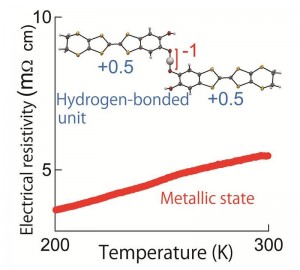Discovery of metallic state in a purely organic single-component conductor

Organic materials are often used as insulators, for example as the insulating coating of a wire. However, the field of organic electronics aims to develop organic materials that are highly conductive, similar to copper wire. Single-component organic conductors that have been developed so far are semiconductors with room-temperature conductivities of 10-6~10-1 Scm-1 because of large Coulomb repulsion between the electrons and small molecular interactions.

Figure: Structure of the molecular unit and electrical resistivity in the purely organic single-component conductor.© Hatsumi MORI
The purely organic single-component conductor developed by Mori’s group with record conductivity at room temperature (19 Scm-1) is composed of electrically neutral and symmetric molecular units, where the charge is widely delocalized. The assembled units form two-dimensional conducting layers which afford the metallic state under low pressure of around 10 katm.
A team led by Professor Hatsumi Mori at the Institute for Solid State Physics, the University of Tokyo, has developed a new type of purely organic single-component conductor. This material has the highest room-temperature conductivity (19 Scm-1) and transitions into a metallic state at the lowest pressure (~10 k atm) yet achieved among purely organic single-component conductors.
Collaborative work with teams led by Professors Yoichi Murakami and Reiji Kumai at the Institute of Materials Structure Science, KEK, and Junior Staff Researcher Akiko Nakao at the Comprehensive Research Organization for Science and Society (CROSS) showed the newly developed, highly conductive organic single-component material is composed of highly symmetric molecular units linked by strong hydrogen bonds to form two-dimensional conductive layers.
Organic materials are generally soluble and therefore can be applied to printed electronics. One anticipated use of this material is as a next-generation organic electronic material, for example, for single-component organic wiring.
The results of this research have been published in Nature Communications.
Ppress release [pdf] (Japanese)
Paper
T. Isono, H. Kamo, A. Ueda, K. Takahashi, A. Nakao, R. Kumai, H. Nakao, K. Kobayashi, Y. Murakami, and H. Mori,
“Hydrogen bond-promoted metallic state in a purely organic single-component conductor under pressure”,
Nature Communications Online Edition: 2013/1/9 (Japan time), doi: 10.1038/ncomms2352.
Article link
Links
Institute for Solid State Physics
Graduate School of Frontier Sciences
Department of Advanced Materials Science, Graduate School of Frontier Sciences
Mori Laboratory, Institute for Solid State Physics(Japanese)
High Energy Accelerator Research Organization (KEK)
Comprehensive Research Organization(Japanese)






